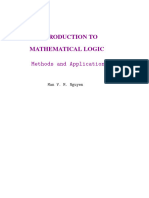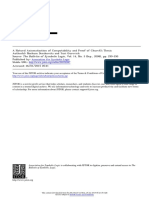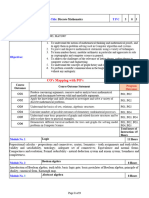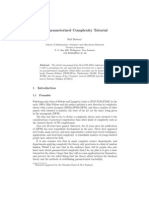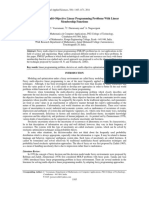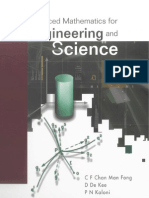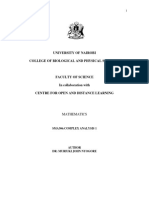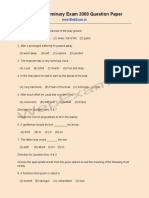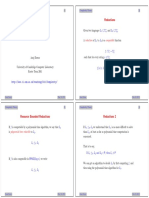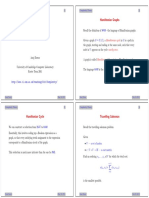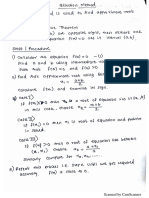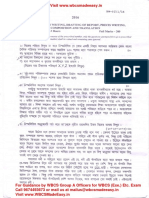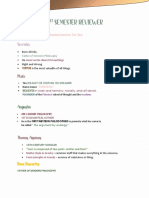Complexity Theory: Texts
Complexity Theory: Texts
Uploaded by
Subhasis MaityCopyright:
Available Formats
Complexity Theory: Texts
Complexity Theory: Texts
Uploaded by
Subhasis MaityOriginal Description:
Original Title
Copyright
Available Formats
Share this document
Did you find this document useful?
Is this content inappropriate?
Copyright:
Available Formats
Complexity Theory: Texts
Complexity Theory: Texts
Uploaded by
Subhasis MaityCopyright:
Available Formats
Complexity Theory 1 Complexity Theory 2
Texts
Complexity Theory
The main texts for the course are:
Lecture 1
Computational Complexity.
Christos H. Papadimitriou.
Introduction to the Theory of Computation.
Michael Sipser.
Other useful references include:
Anuj Dawar
Computers and Intractability: A guide to the theory of
NP-completeness.
University of Cambridge Computer Laboratory
Michael R. Garey and David S. Johnson.
Easter Term 2011
Computational complexity: a conceptual perspective.
O. Goldreich.
http://www.cl.cam.ac.uk/teaching/1011/Complexity/
Computability and Complexity from a Programming Perspective.
Neil Jones.
Anuj Dawar May 2, 2011 Anuj Dawar May 2, 2011
Complexity Theory 3 Complexity Theory 4
Outline Outline - contd.
A rough lecture-by-lecture guide, with relevant sections from the • Sets, numbers and scheduling. 9.4
text by Papadimitriou (or Sipser, where marked with an S).
• coNP. 10.1–10.2.
• Algorithms and problems. 1.1–1.3.
• Cryptographic complexity. 12.1–12.2.
• Time and space. 2.1–2.5, 2.7.
• Space Complexity 7.1, 7.3, S8.1.
• Time Complexity classes. 7.1, S7.2.
• Hierarchy 7.2, S9.1.
• Nondeterminism. 2.7, 9.1, S7.3.
• Descriptive Complexity 5.6, 5.7.
• NP-completeness. 8.1–8.2, 9.2.
• Graph-theoretic problems. 9.3
Anuj Dawar May 2, 2011 Anuj Dawar May 2, 2011
Complexity Theory 5 Complexity Theory 6
Lectures Complexity Theory
Lectures here on MWF 12:00 Complexity Theory seeks to understand what makes certain
problems algorithmically difficult to solve.
except:
• Monday, 9th May, at 9:00
In Algorithms I and II, we have seen how to measure the complexity
• Monday, 16th May, at 11:00 (swapping slots with Databases) of specific algorithms, by asymptotic measures of number of steps.
In Computation Theory, we saw that certain problems were not
solvable at all, algorithmically.
These are prerequisites for the present course.
Anuj Dawar May 2, 2011 Anuj Dawar May 2, 2011
Complexity Theory 7 Complexity Theory 8
Algorithms and Problems Lower and Upper Bounds
Insertion Sort runs in time O(n2 ), while Merge Sort is an What is the running time complexity of the fastest algorithm that
O(n log n) algorithm. sorts a list?
The first half of this statement is short for: By the analysis of the Merge Sort algorithm, we know that this is
no worse than O(n log n).
If we count the number of steps performed by the Insertion
Sort algorithm on an input of size n, taking the largest The complexity of a particular algorithm establishes an upper
such number, from among all inputs of that size, then the bound on the complexity of the problem.
function of n so defined is eventually bounded by a To establish a lower bound, we need to show that no possible
constant multiple of n2 . algorithm, including those as yet undreamed of, can do better.
In the case of sorting, we can establish a lower bound of Ω(n log n),
It makes sense to compare the two algorithms, because they seek to showing that Merge Sort is asymptotically optimal.
solve the same problem.
Sorting is a rare example where known upper and lower bounds
But, what is the complexity of the sorting problem? match.
Anuj Dawar May 2, 2011 Anuj Dawar May 2, 2011
Complexity Theory 9 Complexity Theory 10
Review Lower Bound on Sorting
The complexity of an algorithm (whether measuring number of An algorithm A sorting a list of n distinct numbers a1 , . . . , an .
steps, or amount of memory) is usually described asymptotically:
ai < aj ?
Definition
For functions f : IN → IN and g : IN → IN, we say that: a k < al ?
a p < aq ?
• f = O(g), if there is an n0 ∈ IN and a constant c such that for
ar < a. s ?
all n > n0 , f (n) ≤ cg(n); .
.
.
.
.
.
.
.
.
.
.
.
.
.
• f = Ω(g), if there is an n0 ∈ IN and a constant c such that for
all n > n0 , f (n) ≥ cg(n). done done done done done
• f = θ(g) if f = O(g) and f = Ω(g).
To work for all permutations of the input list, the tree must have at
Usually, O is used for upper bounds and Ω for lower bounds. least n! leaves and therefore height at least log2 (n!) = θ(n log n).
Anuj Dawar May 2, 2011 Anuj Dawar May 2, 2011
Complexity Theory 11 Complexity Theory 12
Travelling Salesman Complexity of TSP
Given Obvious algorithm: Try all possible orderings of V and find the
one with lowest cost.
• V — a set of nodes.
The worst case running time is θ(n!).
• c : V × V → IN — a cost matrix.
Find an ordering v1 , . . . , vn of V for which the total cost: Lower bound: An analysis like that for sorting shows a lower
bound of Ω(n log n).
X
n−1
c(vn , v1 ) + c(vi , vi+1 )
i=1 Upper bound: The currently fastest known algorithm has a
running time of O(n2 2n ).
is the smallest possible.
Between these two is the chasm of our ignorance.
Anuj Dawar May 2, 2011 Anuj Dawar May 2, 2011
Complexity Theory 13
Formalising Algorithms
To prove a lower bound on the complexity of a problem, rather
than a specific algorithm, we need to prove a statement about all
algorithms for solving it.
In order to prove facts about all algorithms, we need a
mathematically precise definition of algorithm.
We will use the Turing machine.
The simplicity of the Turing machine means it’s not useful
for actually expressing algorithms, but very well suited for
proofs about all algorithms.
Anuj Dawar May 2, 2011
You might also like
- Dokumen - Pub The Gospel of Christ Crucified A Theology of Suffering Before GloryDocument742 pagesDokumen - Pub The Gospel of Christ Crucified A Theology of Suffering Before GloryFelipe AndradeNo ratings yet
- M832 Approximation Theory Course NotesDocument94 pagesM832 Approximation Theory Course NotesViator in Terra100% (1)
- CNC Turning Skt28 Series IDocument16 pagesCNC Turning Skt28 Series IcncturNo ratings yet
- MATH-101 - Calculus Analytical Geometry (OBE) Fall 2018Document5 pagesMATH-101 - Calculus Analytical Geometry (OBE) Fall 2018Usama KhurshidNo ratings yet
- Computers, Rigidity, and Moduli: The Large-Scale Fractal Geometry of Riemannian Moduli SpaceFrom EverandComputers, Rigidity, and Moduli: The Large-Scale Fractal Geometry of Riemannian Moduli SpaceNo ratings yet
- Minorsky Nonlinear OscillationsDocument14 pagesMinorsky Nonlinear OscillationsMatejaBoskovicNo ratings yet
- Chemical Engineering 3rd&4th Semester SyllabusDocument10 pagesChemical Engineering 3rd&4th Semester Syllabusadityakushwaha371No ratings yet
- Schuller39s Geometric Anatomy of Theoretical Physics Lectures 1 17 PDFDocument114 pagesSchuller39s Geometric Anatomy of Theoretical Physics Lectures 1 17 PDFmfgobbi4515100% (1)
- Interdisciplinary Approach to P vs. NP: Integrating Set Theory, Graph Theory, and Quantum MechanicsDocument15 pagesInterdisciplinary Approach to P vs. NP: Integrating Set Theory, Graph Theory, and Quantum MechanicsSamir Amier Saliem Boulos0% (1)
- MAT5001 Foundations-Of-Mathematics ETH 1 AC40Document3 pagesMAT5001 Foundations-Of-Mathematics ETH 1 AC40Karan DesaiNo ratings yet
- Advances in Quantum Field TheoryDocument242 pagesAdvances in Quantum Field TheoryRishabhNo ratings yet
- PROPOSITONAL-LOGIC-THEORY-2025Document41 pagesPROPOSITONAL-LOGIC-THEORY-2025EugeneNo ratings yet
- Quantum Information Theory Chapter 1Document12 pagesQuantum Information Theory Chapter 1juanNo ratings yet
- 2011 Book ComplexAnalysisDocument466 pages2011 Book ComplexAnalysisYeung Shing Ho100% (1)
- Complex Analysis 1 Latest (Repaired)Document117 pagesComplex Analysis 1 Latest (Repaired)Mel WintersNo ratings yet
- Book of Abstracts of LC2023Document192 pagesBook of Abstracts of LC2023Joaquin Santiago Toranzo CalderonNo ratings yet
- Mat CDZ EnumerateDocument8 pagesMat CDZ EnumerateEMellaNo ratings yet
- Complex Analysis.docxDocument1 pageComplex Analysis.docxjayanta.biswasNo ratings yet
- 2008 - DERSHOWITZ, N. GUREVICH, Y. A Natural Axomatization of Computability and Proof of Church's ThesisDocument53 pages2008 - DERSHOWITZ, N. GUREVICH, Y. A Natural Axomatization of Computability and Proof of Church's ThesislorenziksNo ratings yet
- Complex Analysis Syllabus IILM MSc MathsDocument1 pageComplex Analysis Syllabus IILM MSc Mathsjayanta.biswasNo ratings yet
- Quantum Mechanics PPT4Document19 pagesQuantum Mechanics PPT4shivamkhandelwal200329No ratings yet
- Goldreich O. Introduction To Complexity TheoryDocument375 pagesGoldreich O. Introduction To Complexity TheoryManuel Sanchez Lopez100% (1)
- Computational Mathematics NotesDocument129 pagesComputational Mathematics NotessatishNo ratings yet
- Nptel: Complex Analysis - Video CourseDocument3 pagesNptel: Complex Analysis - Video CourseGaurav VarshneyNo ratings yet
- MM-CHAPTER-1-Advanced-LOGIC-landscapeDocument164 pagesMM-CHAPTER-1-Advanced-LOGIC-landscapengodiemquyen69No ratings yet
- Towards a Theory of Everything, Part II; Introduction of Consciousness in Schrödinger Equation and Standard ModelDocument11 pagesTowards a Theory of Everything, Part II; Introduction of Consciousness in Schrödinger Equation and Standard ModelGuni GoogooNo ratings yet
- Solving Ordinary Differential Equations and Systems using Neural Network MethodsDocument77 pagesSolving Ordinary Differential Equations and Systems using Neural Network MethodsprakashjayavelNo ratings yet
- MAT1016Document3 pagesMAT1016ms harshithaNo ratings yet
- Overview of Some Solved NP-complete Problems in Graph TheoryDocument11 pagesOverview of Some Solved NP-complete Problems in Graph TheoryAndika Dwi NugrahaNo ratings yet
- A Parameterized Complexity TutorialDocument19 pagesA Parameterized Complexity TutorialbobysiswantoNo ratings yet
- Math 8 DLL Feb 13 17 2023Document3 pagesMath 8 DLL Feb 13 17 2023etheyl fangonNo ratings yet
- Expected No. of Questions For Exams Lecturer TOPIC Details TCEM 1101 ENGINEERING MATHEMATICS I SEM-I YR I-2020/2021 Topics and LecturersDocument1 pageExpected No. of Questions For Exams Lecturer TOPIC Details TCEM 1101 ENGINEERING MATHEMATICS I SEM-I YR I-2020/2021 Topics and Lecturersgeorge willsNo ratings yet
- EETD Course Plan (Probability and Statistics)Document6 pagesEETD Course Plan (Probability and Statistics)Raja ahmerNo ratings yet
- CC Key TermsDocument3 pagesCC Key Termszaroon sajidNo ratings yet
- DISCRETE STRUCTURES I OUTLINEDocument5 pagesDISCRETE STRUCTURES I OUTLINEenock4483No ratings yet
- Engineering Statics: Instructor: Chapter 1: IntroductionDocument15 pagesEngineering Statics: Instructor: Chapter 1: IntroductionProf. DesignNo ratings yet
- Solv AbilityDocument279 pagesSolv AbilityLuis DanielNo ratings yet
- Syllabus DAA - CSH2G3 1617Document6 pagesSyllabus DAA - CSH2G3 1617Syam Redaxto IntelNo ratings yet
- Solving Fuzzy Multi-Objective Linear Programming Problems With Linear Membership FunctionsDocument9 pagesSolving Fuzzy Multi-Objective Linear Programming Problems With Linear Membership Functionsad_mih7867No ratings yet
- CS I Sem Mathematics 1 BMATS101Document3 pagesCS I Sem Mathematics 1 BMATS101jayanthmohan18No ratings yet
- Advanced Mathematics For Engineering and Sciences - 2Document898 pagesAdvanced Mathematics For Engineering and Sciences - 2Tran Dang Hoa100% (1)
- (MPS-SIAM series on optimization) James Renegar - A mathematical view of interior-point methods in convex optimization-Society for Industrial and Applied Mathematics _, Mathematical Programming Societ.pdfDocument126 pages(MPS-SIAM series on optimization) James Renegar - A mathematical view of interior-point methods in convex optimization-Society for Industrial and Applied Mathematics _, Mathematical Programming Societ.pdfChristian JúniorNo ratings yet
- Tubingen DL NotesDocument151 pagesTubingen DL NotesArun JanaNo ratings yet
- Introduction To Theory of The ComplexityDocument290 pagesIntroduction To Theory of The Complexityphuongvc100% (1)
- Physics-Informed Neural NetworkThe Effect of For Sloving Differential EquationsDocument8 pagesPhysics-Informed Neural NetworkThe Effect of For Sloving Differential Equationsp218033No ratings yet
- Integral Calculus: The Fundamental Theorem of CalculusDocument33 pagesIntegral Calculus: The Fundamental Theorem of Calculusaerogem618No ratings yet
- CEE570 ppt1 Revised2014Document20 pagesCEE570 ppt1 Revised2014drp100% (1)
- COMPLEX ANALYSIS 1 LATEST (Repaired)Document118 pagesCOMPLEX ANALYSIS 1 LATEST (Repaired)koskeyemmanuel82No ratings yet
- Nptel: Finite Element Analysis - Web CourseDocument4 pagesNptel: Finite Element Analysis - Web CourseArun PVNo ratings yet
- Handbook of Numerical Analysis: Volume I, Finite Difference Method I, Solutions of Equations in R N (RN) IDocument651 pagesHandbook of Numerical Analysis: Volume I, Finite Difference Method I, Solutions of Equations in R N (RN) IRivo Carapucci100% (1)
- Manifolds and FormsDocument153 pagesManifolds and FormstempestaNo ratings yet
- Spectral Theorem For DummiesDocument19 pagesSpectral Theorem For DummiesxunxunNo ratings yet
- Mathematics - Foundations of CalculusDocument182 pagesMathematics - Foundations of CalculusJorge100% (16)
- The Neumann Problem for the Cauchy-Riemann ComplexFrom EverandThe Neumann Problem for the Cauchy-Riemann ComplexRating: 4 out of 5 stars4/5 (2)
- Introduction to Differential Equations with Dynamical SystemsFrom EverandIntroduction to Differential Equations with Dynamical SystemsRating: 4 out of 5 stars4/5 (2)
- Three Views of Logic: Mathematics, Philosophy, and Computer ScienceFrom EverandThree Views of Logic: Mathematics, Philosophy, and Computer ScienceNo ratings yet
- 15-451 Algorithms, Fall 2011Document3 pages15-451 Algorithms, Fall 2011Subhasis MaityNo ratings yet
- WBCS 2009 Prelims - WebExamDocument22 pagesWBCS 2009 Prelims - WebExamSubhasis MaityNo ratings yet
- Follow Exam Focus Channel For Latest VideosDocument6 pagesFollow Exam Focus Channel For Latest VideosSubhasis MaityNo ratings yet
- Complexity Theory: Formalising AlgorithmsDocument4 pagesComplexity Theory: Formalising AlgorithmsSubhasis MaityNo ratings yet
- Bhakti Movement: by Siddhant Agnihotri B.SC (Silver Medalist) M.SC (Applied Physics)Document16 pagesBhakti Movement: by Siddhant Agnihotri B.SC (Silver Medalist) M.SC (Applied Physics)Subhasis MaityNo ratings yet
- Complexity Theory: ReductionsDocument4 pagesComplexity Theory: ReductionsSubhasis MaityNo ratings yet
- Complexity Theory: Hamiltonian GraphsDocument4 pagesComplexity Theory: Hamiltonian GraphsSubhasis MaityNo ratings yet
- Bisection MethodDocument3 pagesBisection MethodSubhasis MaityNo ratings yet
- Ee 211 PDFDocument2 pagesEe 211 PDFSubhasis MaityNo ratings yet
- Banking in India For WbcsDocument29 pagesBanking in India For WbcsSubhasis MaityNo ratings yet
- WWW Wbcsmadeeasy inDocument2 pagesWWW Wbcsmadeeasy inSubhasis MaityNo ratings yet
- WBCS Main 2015 Question Paper - Bengali CompulsoryDocument2 pagesWBCS Main 2015 Question Paper - Bengali CompulsorySubhasis MaityNo ratings yet
- Temperature AtmosphereDocument7 pagesTemperature AtmosphereSubhasis MaityNo ratings yet
- Current Affairs Test Series 4Document32 pagesCurrent Affairs Test Series 4Subhasis MaityNo ratings yet
- WBCS Main 2016 Bengali Compulsory Question Paper PDFDocument2 pagesWBCS Main 2016 Bengali Compulsory Question Paper PDFSubhasis MaityNo ratings yet
- History Mock 2 - QDocument52 pagesHistory Mock 2 - QSubhasis MaityNo ratings yet
- Design Analysis of Algorithms: Technology, West BengalDocument7 pagesDesign Analysis of Algorithms: Technology, West BengalSubhasis MaityNo ratings yet
- Ocean Water WavesDocument7 pagesOcean Water WavesSubhasis Maity100% (1)
- 1478604331cs Btech Cse Odd Sem 5th Cs 501 2014 15 - ExamvedaDocument4 pages1478604331cs Btech Cse Odd Sem 5th Cs 501 2014 15 - ExamvedaSubhasis MaityNo ratings yet
- WWW Wbcsmadeeasy inDocument2 pagesWWW Wbcsmadeeasy inSubhasis MaityNo ratings yet
- Additional ProblemsDocument2 pagesAdditional ProblemsSubhasis MaityNo ratings yet
- Chindu Bhagavatham: Onlyias March 9, 2018Document1 pageChindu Bhagavatham: Onlyias March 9, 2018Subhasis MaityNo ratings yet
- Different TsDocument10 pagesDifferent TsSubhasis MaityNo ratings yet
- Qb Cse3348 Genrative Ai-1Document3 pagesQb Cse3348 Genrative Ai-1shettyravi341No ratings yet
- Principles of Compiler DesignDocument36 pagesPrinciples of Compiler DesignSathyamurthy DuraikkannuNo ratings yet
- TWIX-1 MNLDocument2 pagesTWIX-1 MNLsrboghe651665No ratings yet
- Welq: Evsjv Cö - Gcî: Bangladesh International School & CollegeDocument20 pagesWelq: Evsjv Cö - Gcî: Bangladesh International School & CollegeTanzir MollikNo ratings yet
- Roadmap B2Document19 pagesRoadmap B2KaterynaNo ratings yet
- Get Fundamentals of Python: Data Structures 2nd Edition Kenneth A. Lambert Free All ChaptersDocument52 pagesGet Fundamentals of Python: Data Structures 2nd Edition Kenneth A. Lambert Free All Chaptersmunirathey100% (7)
- SSC + OSSC - CGL (Syllabus)Document5 pagesSSC + OSSC - CGL (Syllabus)AnantNo ratings yet
- TOPIKDocument3 pagesTOPIKAdi NugrahaNo ratings yet
- PG M.A. English 320 42 American Literature 9957Document224 pagesPG M.A. English 320 42 American Literature 9957tienhvNo ratings yet
- Working With IptablesDocument10 pagesWorking With IptablesMordor ChaliceNo ratings yet
- HW5e Advanced TR Tests Unit8Document15 pagesHW5e Advanced TR Tests Unit8c4153711No ratings yet
- HCIA AI Dump FileDocument180 pagesHCIA AI Dump Filejunaid ahmedNo ratings yet
- Fancy Title 1Document32 pagesFancy Title 1Kiko NobreNo ratings yet
- Lab Instructions: Local File Inclusion (LFI) Attack Using Metasploitable and Kali LinuxDocument4 pagesLab Instructions: Local File Inclusion (LFI) Attack Using Metasploitable and Kali Linuxk.k.deenadhayalan1410No ratings yet
- Convert A Python 3.5 Script (.Py) To A Windows Executable (.Exe)Document8 pagesConvert A Python 3.5 Script (.Py) To A Windows Executable (.Exe)Tchio PokamNo ratings yet
- CulturesDocument3 pagesCulturesvanjushkaNo ratings yet
- 1st Semester Reviewer (UTS)Document4 pages1st Semester Reviewer (UTS)sonny saynoNo ratings yet
- Grade 5: Module 2BDocument1,014 pagesGrade 5: Module 2BRivka ShareNo ratings yet
- Lab 3Document7 pagesLab 3M DNo ratings yet
- Canals and StraitsDocument1 pageCanals and Straitssabiralam1395No ratings yet
- TOC - Assignment 1Document10 pagesTOC - Assignment 1Zeeshan NawazNo ratings yet
- Tata Spasial Arsitektur Tradisional Suku Atoni Di Kampung Tamkesi Pulau TimorDocument13 pagesTata Spasial Arsitektur Tradisional Suku Atoni Di Kampung Tamkesi Pulau TimorMuamar SerajawaNo ratings yet
- Lesson 2 Activity 4: Learning TasksDocument3 pagesLesson 2 Activity 4: Learning TasksRobi AmosNo ratings yet
- 5é Dev 1 2024-2025Document2 pages5é Dev 1 2024-2025dambreromaric543No ratings yet
- ITPROG3L - Lab Exercise 4 (Creating Classes and Objects)Document4 pagesITPROG3L - Lab Exercise 4 (Creating Classes and Objects)Rochelle PadillaNo ratings yet
- Digging Deep 001 100Document166 pagesDigging Deep 001 100Samson Mide Folorunsho100% (1)
- 数学分析习题课讲义(复旦大学 PDFDocument88 pages数学分析习题课讲义(复旦大学 PDFradioheadddddNo ratings yet
- An Inspector Calls 2022 23 Lesson 19 Gerald STUDENTDocument43 pagesAn Inspector Calls 2022 23 Lesson 19 Gerald STUDENTlexiNo ratings yet












